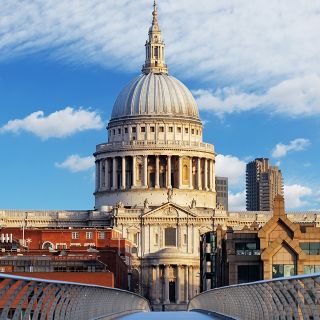St. Paul's Cathedral
Completed in 1710, the current iteration of St. Paul's Cathedral was designed by the famous architecht, Sir Christopher Wren. Its soaring dome is an icon of London, and visitors will have the opportunity to climb and explore it from three different viewing galleries, along with the expansive subterranean crypt. Admission also includes multimedia guides and guided tours. Marvel at the grand spectacle of the Cathedral's lavishly appointed baroque interior, then climb the stairs to take in sweeping views of London from the Stone and Golden Galleries. Explore the crypt to find famous names, study the elements of the Cathedral's classical features, and discover how Wren's clever designs made this masterpiece a reality.
More Info Read LessAn Icon of Spirit
The image of St. Pauls stands as an icon of London's spirit. As recently as 1967, it was the tallest building in the city, and had dominated the skyline for over 300 years. During WWII, it is said that Winston Churchill ordered all fire-fighting apparatus to protect St. Paul's from incendiary bombs. It stood for pride and resilience, and Churchill feared that damage to the cathedral would in turn damage the nation's morale. The famous Blitz photograph St. Paul's Survives, by Herbert Mason, shows the dome of St. Paul's rising pure and untouched from a wreath of bomb smoke.
Encapsulating London History
The present St. Paul's Cathedral is thought to be the 5th Christian church dedicated to St. Paul that has stood on Ludgate Hill. The 4th St. Paul's, known as Old St Paul's, was an enormous gothic cathedral that was destroyed during the Great Fire of 1666. The new St. Pauls has weathered its own share of tumult, notably surviving the Blitz of WWII. On 12 September 1940 a time-delayed bomb struck the cathedral. It was successfully defused and removed, later leaving a 100-foot (30 m) crater when remotely detonated in a secure location. Had it successfully detonated, St. Paul's would have been destroyed.
The Dome
St. Paul's dome is one of the largest cathedral domes in the world, rising to a height of just over 111 metres. Supported by eight different pillars, it weighs 65,000 tonnes. It's not immediately obvious, but there are actually two domes - the internal dome, which rises to 225ft (68m), and the external dome, which rises to 278ft (85m). The external dome is supported by an internal brick cone. The final stone was placed on the dome's lantern on 26 October 1708 by Christopher Wren's son, Christopher Jr. When observing the dome from the Whispering Gallery, visitors will notice that noises are extraordinarily amplified.
The Galleries and Crypt
Visitors to St. Pauls will be able to explore the magnificent structure from three different galleries, and the crypt. The Whispering Gallery runs around the interior of the dome, and is so-named as a whisper uttered on one side of the gallery can be heard on the other side. The Golden Gallery and the Stone Gallery both run around the outdoor exterior of the dome - the Stone Gallery is 52 metres above the Cathedral's floor at the bottom of the dome, and the Golden Gallery is at the top of the dome, 85 metres above the Cathedral floor. The Crypt, one of the largest in the world, contains over 200 memorials and tombs. Christopher Wren was the first person to be interred, in 1723. On the wall above his tomb is written in Latin: Lector, si monumentum requiris, circumspice ("Reader, if you seek his monument, look around you").


